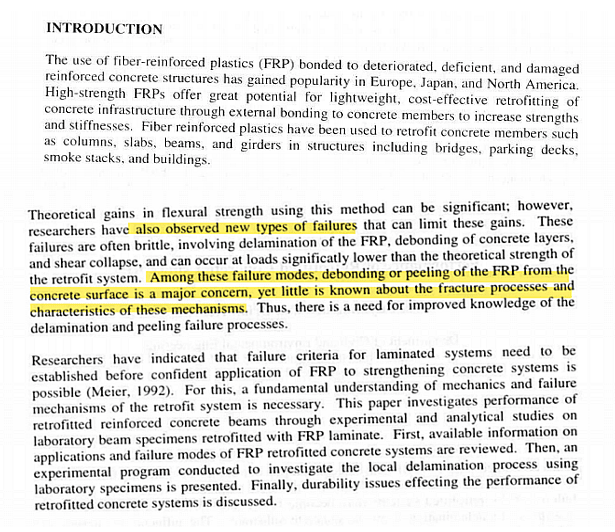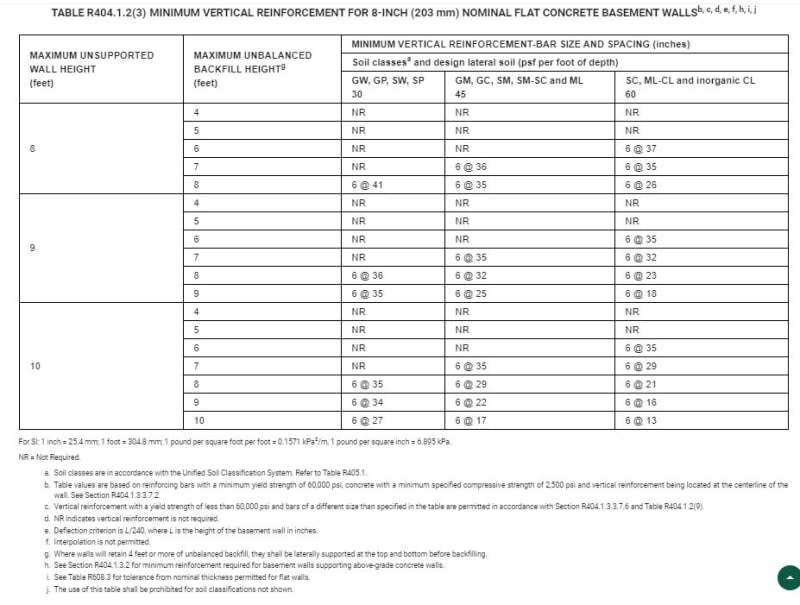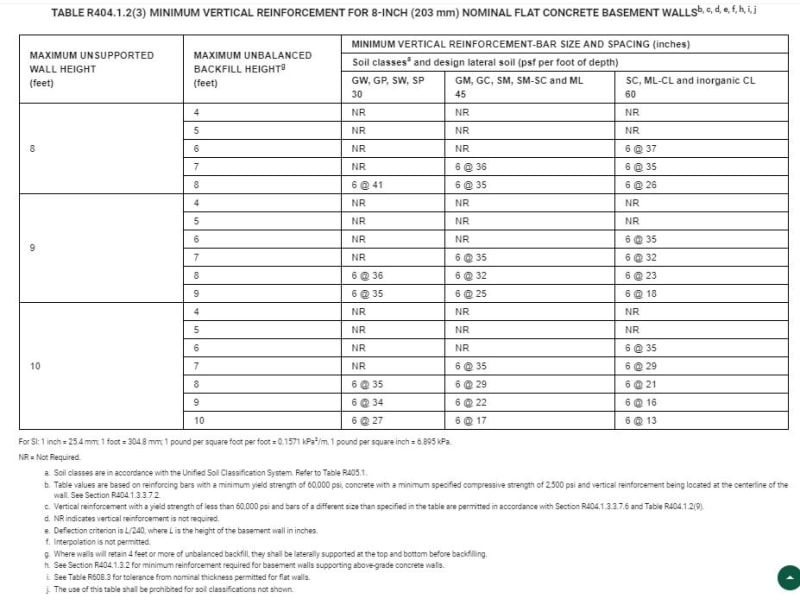So a local home builder takes it upon himself to turn the foundation area under a covered porch into a root cellar. Nor not a big deal. However, he never contacted the engineer prior to making changes. The problem is the area under the porch floor was designed to be back filled (footings at 42”). The builder sunk the footings and extended poured concrete wall height to 8ft and no vertical reinforcement was added. The wall is 8” poured concrete with #4 bar horizontal (2 rows), doweled #4 bars from footing to base of the wall at 2’cc. I am trying to assist him with some ideas to reinforce the wall. Does anyone have ideas? I’ve thought about FRP strengthening, pouring a reinforced sister wall on the outside of the existing wall. Additionally, the porch floor and root cellar floor have already been poured. Thoughts?
Navigation
Install the app
How to install the app on iOS
Follow along with the video below to see how to install our site as a web app on your home screen.
Note: This feature may not be available in some browsers.
More options
-
Congratulations waross on being selected by the Eng-Tips community for having the most helpful posts in the forums last week. Way to Go!
You are using an out of date browser. It may not display this or other websites correctly.
You should upgrade or use an alternative browser.
You should upgrade or use an alternative browser.
Strengthen un-reinforced basement wall 1
- Thread starter Nice23
- Start date
- Status
- Not open for further replies.
- Thread starter
- #2
Unfortunately the ‘engineer’ is a architect who does not have structural design experience. I am the engineer he’s asking for some options. I am looking to see if anyone has any experience with a similar issue and can offer design options. I don’t have a problem designing a remedy. Just looking to explore all options. Thanks for input
- Thread starter
- #5
Yes I have considered the ACI requirement. It is an option....albeit not a great option. The contractor would still need to excavate all the back fill material and replace with some clean well draining material. They just backfill with on-site material which is clay. I could see if keeping the finished grade down closer to 6ft for some added insurance. Thank you for both posts....
Any experience with FRP strengthening on the inside walls? Other?
Any experience with FRP strengthening on the inside walls? Other?
I'd also consider whether two way action on walls shows that it works w/o reinforcing. Maybe you could add buttresses on the inside face to make it work. Otherwise the additional wall outside seems promising.
FRP is expensive and, in my experience, hard to find contractors who will do it on a small scale residential. Probably not worth it for a space that nobody wanted in the first place.
FRP is expensive and, in my experience, hard to find contractors who will do it on a small scale residential. Probably not worth it for a space that nobody wanted in the first place.
JoshPlumSE
Structural
kipfoot said:Maybe you could add buttresses on the inside face to make it work. Otherwise the additional wall outside seems promising.
I was thinking something along these lines as well. Some full height beams spaces intermittently that are doweled into the wall will probably do. For that matter, I wonder if you can attach steel angles or channels (via epoxy anchors) into the wall to strengthen it against bending. It would keep a pretty low profile and not intrude into the space much.
If it works, I think FRP (as you suggested) is probably the most elegant option. But, it's also probably a bit expensive. Though I've never priced it out.
Nice23,
The linked article, from MIT, is titled "Performance of Retrofitted Concrete Using FRP" which should be of your interest. The image below contains the introduction for quick review. I am holding "wait and see" attitude towards this technology. Link

The linked article, from MIT, is titled "Performance of Retrofitted Concrete Using FRP" which should be of your interest. The image below contains the introduction for quick review. I am holding "wait and see" attitude towards this technology. Link

- Thread starter
- #9
Thanks. We have a few local contractors in the area that install FRP for basement walls but what's the warranty? Most of the contractors are waterproof basement guys that probably took a crash course on installation from the manufacturer. Not what I would want on a brand new house! I have some experience in reinforcing prestressed concrete bridge beams but the contractors are more qualified and versed on the structural end of things. I am going to look at the 2 way slab analysis. If I am comfortable with the results, I could have them replace the backfill material and keep the grade down to meet the code. I am leaning toward a sister wall on the outside with additional footing ($$$).
- Thread starter
- #10
Thanks for FRP post. I know FRP's are susceptible to UV light. The coatings that you apply after installation are suppose to provide protection. Although these would be installed on the interior. I know Simpson Strong Tie sells an FRP and they will even provide complementary site specific designs and construction plans (stamped for your state). But it comes down to installation.
-
1
- #11
I have lots of experience with designing externally bonded CFRP. It is by far the least obtrusive and can be installed in a day. No way new footings, tying rebar, forming, and pumping concrete can be done in any less than a week.
Bond is everything to the design. They NEED to prep the concrete surface properly and clean it of all dust and laitance. They typically just use a grinder with a cup wheel to roughen the surface to at LEAST CSP 3 although I typically specify CSP 4. Good luck getting it though.
I estimate CFRP to be $100 per sq. ft. Per layer. I live in an expensive locale so you may be a bit cheaper but the material is expensive regardless.
You're looking for ACI 440.2R. it's a lot to take in but since you said you have some experience with it maybe you can crank out the design quickly. The equations with all the variables are some of the longest I've ever run across. Once you understand it, it's all strain compatibility based. You will hardly ever reach ultimate strength of the material and will typically be governed by delamination of the material with the concrete. Due to the brittle nature of the failures, there are some pretty conservative strength reduction factors to take. On a side note, some of the manufacturers will even run the design for you free of charge if you use their product but you need to provide them with the demands.
FRP typically comes in 2ft wide strips. I would rip it in 12" wide strips and bond those to the surface and space them out as the design demands it. Run it from top to bottom.
Make sure the Contractor is a certified applicator through the FRP manufacturer. Doesn't mean they are for sure going to be top notch but it's at least a start.
I typically always specify the Fyfe product because I know they have put in the most research, quality control, and customer service. I do not in any way work for them but they are the original and the best in my opinion. I have never used the Simpson product but they certainly gear themselves more to the small time Contractor/DIY crowd. They typically are cheaper. I remember one trade show them trying to sell me on their pre-saturated FRP in a bag! Haha.
Bond is everything to the design. They NEED to prep the concrete surface properly and clean it of all dust and laitance. They typically just use a grinder with a cup wheel to roughen the surface to at LEAST CSP 3 although I typically specify CSP 4. Good luck getting it though.
I estimate CFRP to be $100 per sq. ft. Per layer. I live in an expensive locale so you may be a bit cheaper but the material is expensive regardless.
You're looking for ACI 440.2R. it's a lot to take in but since you said you have some experience with it maybe you can crank out the design quickly. The equations with all the variables are some of the longest I've ever run across. Once you understand it, it's all strain compatibility based. You will hardly ever reach ultimate strength of the material and will typically be governed by delamination of the material with the concrete. Due to the brittle nature of the failures, there are some pretty conservative strength reduction factors to take. On a side note, some of the manufacturers will even run the design for you free of charge if you use their product but you need to provide them with the demands.
FRP typically comes in 2ft wide strips. I would rip it in 12" wide strips and bond those to the surface and space them out as the design demands it. Run it from top to bottom.
Make sure the Contractor is a certified applicator through the FRP manufacturer. Doesn't mean they are for sure going to be top notch but it's at least a start.
I typically always specify the Fyfe product because I know they have put in the most research, quality control, and customer service. I do not in any way work for them but they are the original and the best in my opinion. I have never used the Simpson product but they certainly gear themselves more to the small time Contractor/DIY crowd. They typically are cheaper. I remember one trade show them trying to sell me on their pre-saturated FRP in a bag! Haha.
- Thread starter
- #12
r13, there is nothing to "wait and see". It's not really a new technology. There is a ton of information out there on the performance of externally bonded CFRP. There is a really great research report out there (can't remember if it was AASHTO, NCHRP, or a State DOT) but they had taken an AASHTO bridge girder that had been damaged due to an impact of a truck. The girder had midspan severed strands and looked like hell. They rehabilitated it with CFRP and load tested it. Performance and capacity was extremely impressive.
It is in no way the greatest thing since sliced bread but it certainly has its appropriate use and can be a great tool in an Engineer's kit when needing to solve a design problem. The key is knowing when it is appropriate for use and whether it makes sense over other conventional options.
It is in no way the greatest thing since sliced bread but it certainly has its appropriate use and can be a great tool in an Engineer's kit when needing to solve a design problem. The key is knowing when it is appropriate for use and whether it makes sense over other conventional options.
I love epoxy, but I'll be a-Googlin' Fyfe and others about how dry the concrete must be for a successful application.
In the end, if I ever have a similar situation I'd be considering some mechanical anchors liberally sprinkled on (into) the wall and consider the epoxy bond as a "secondary" feature.
I'm recollecting some MIL aircraft spec that pretty much demoted ANY bonding after the original processing to secondary components/structures.
The primary structure had to be done in the first shot.
I think the much lower strength fiber reinforced surface bonding cements // might// have a more reliable bond, and thus //might// be an overall 20 year winner.
In the end, if I ever have a similar situation I'd be considering some mechanical anchors liberally sprinkled on (into) the wall and consider the epoxy bond as a "secondary" feature.
I'm recollecting some MIL aircraft spec that pretty much demoted ANY bonding after the original processing to secondary components/structures.
The primary structure had to be done in the first shot.
I think the much lower strength fiber reinforced surface bonding cements // might// have a more reliable bond, and thus //might// be an overall 20 year winner.
I think a few of us has had that experience in past... Does the city?/state? have a prescribed foundation wall with no reinforcing? Here in Winnipeg, our standard foundation wall (prescribed) is 9" with 3 horizontal bars, only... and I've always wondered why they would waste 3 bars... Merry Christmas to all...
Rather than think climate change and the corona virus as science, think of it as the wrath of God. Feel any better?
-Dik
We have the contractor install vertical steel angles at 48" on centre attached to the floor system at the top and bottom.
Usually it requires breaking out the concrete slab at the bottom and casting the angle back in. And bolting it to the wood floor system and adding a bunch of blocking to help distribute the load
Usually it requires breaking out the concrete slab at the bottom and casting the angle back in. And bolting it to the wood floor system and adding a bunch of blocking to help distribute the load
... and I've always wondered why they would waste 3 bars...
Reinforced vs unreinforced
STrctPono said:r13, there is nothing to "wait and see". It's not really a new technology.
Yes, the tech was old, but somewhat new to our industry, at least not widely popular in the past. I, for one, never heard of it until very late. A tech needs time to fully prove its effectiveness. I don't think that time is here yet, so rather stay behind and wait to see. Thanks for the valuable information you have provided.
- Thread starter
- #19
Iam in NY and our state uses the IRC plus some supplements.
As far as the Use of FRP’s go... I work in the transportation industry (bridges) and we’ve used FRP for concrete repairs on occasion when it makes since. The material itself probably started to hit our business around 20yrs ago after big cuts in the defense industry. I remember taking classes on it’s different uses to strengthen bridge beams back then. The material itself has been used in the aerospace industry long before that. Incredible strength... but it comes down to that bond and proper installation. In fact we have an entire bridge superstructure built out of FRP. It was a small test site built back in early 2000’s. Not very feasible for that. Sections are enormous and they are susceptible to UV.

As far as the Use of FRP’s go... I work in the transportation industry (bridges) and we’ve used FRP for concrete repairs on occasion when it makes since. The material itself probably started to hit our business around 20yrs ago after big cuts in the defense industry. I remember taking classes on it’s different uses to strengthen bridge beams back then. The material itself has been used in the aerospace industry long before that. Incredible strength... but it comes down to that bond and proper installation. In fact we have an entire bridge superstructure built out of FRP. It was a small test site built back in early 2000’s. Not very feasible for that. Sections are enormous and they are susceptible to UV.

- Status
- Not open for further replies.
Similar threads
- Locked
- Question
- Replies
- 17
- Views
- 63
- Locked
- Question
- Replies
- 0
- Views
- 11
- Locked
- Question
- Replies
- 8
- Views
- 29
- Replies
- 10
- Views
- 47
- Replies
- 16
- Views
- 95

